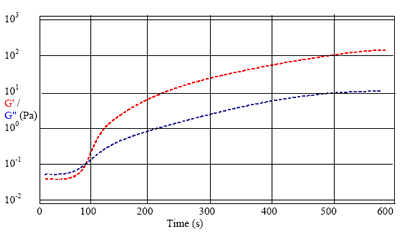The gelation time of foods containing a gel can be dramatically affected by other ingredients in the formulation. The gelant dosing can be adjusted to maintain the same gelling time, despite formulation changes.
Using Shear Viscometry To Measure Structure Build Up
Steady shear viscometry can be used to measure the structure building, although the shearing action inherently retards the structure growth. Using a Bohlin rheometer, it is possible to apply small oscillations to the sample and monitor the structure build-up without hindering the process.
In this experiment, the sample is pre-sheared initially to give a common starting point for all samples. As no gelation has taken place at this stage, the results are not affected.

Figure 1. Plot of gelation time and strength showing the gel point where the elastic and viscous moduli cross over.
Temperature Induced Carrageenan Gelation
Carrageenan gelation is temperature induced, so the sample sets-up when the temperature is ramped down. The temperature at which the gelation occurs will depend on the ionic and gelant concentrations of the mixture as well as the pH.
Interpretation Of Results
Gel Point
In the results shown in figure 1, the sample was initially a thin liquid and the viscous modulus was dominant over the elastic modulus. The crossover point of the elastic and viscous moduli indicates when the sample has reached a ‘gel point’.
Flow Characteristics
Thereafter, the structure becomes predominantly elastic and the sample will not flow. Formulations with an earlier crossover would show less flow before gelation. If the test is run for long enough, the moduli will reach a plateau where it has fully reacted.
Conclusion
A Bohlin rheometer can be used to accurately quantify the gelation times of foods. The formulation can be optimised with regard to gelant dosing in the minimum of time.
Measurement Conditions
|
Samples
|
Carrageenan gels, Xanthan gums or similar
|
|
Geometry
|
60mm Parallel plate system. Stainless steel/titanium
|
|
Temperature
|
80 - 20ºC, ramp down at 3ºC / minute, hold at 20ºC
|
|
Shear rate
|
100s-1
|
|
Shear time
|
10 seconds
|
|
Equilibrium time
|
1 second
|
|
Single Frequency Oscillation
|
|
|
Strain
|
0.005
|
|
Frequency
|
1Hz
|
|
Delay time
|
1 Second
|
|
Wait time
|
0 Seconds
|

This information has been sourced, reviewed and adapted from materials provided by Malvern Panalytical.
For more information on this source, please visit Malvern Panalytical.